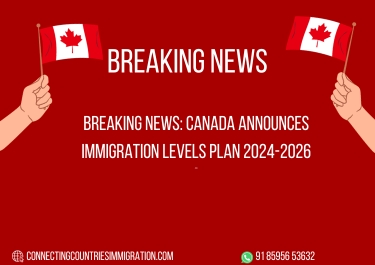BREAKING: Canada announces Immigration Levels Plan 2024-2026
Canada has unveiled its 2024-2026 Immigration Levels Plan.
Canada’s immigration levels will remain the same as they are now. The country intends to admit 485,000 more immigrants by 2024. Canada expects to receive 500,000 additional immigrants each year in 2025 and 2026.
The objectives are the same as those stated in the Immigration Levels Plan 2023-2025. The new information given today includes the 2026 target date, as well as updates on the number of immigrants admitted under each class and program between 2024 and 2026.
Immigration targets broken down by class
In 2024, Canada expects to attract approximately 281,135 economic immigrants, or 58% of the annual target. By 2026, this figure will have risen to 301,250, or 60% of the annual objective.
In 2024, the family class target will be 114,000 immigrants, or 24% of all admissions. This figure will climb to 118,000 immigrants by 2026, accounting for 24% of total admissions.
Humanitarian admission targets for 2024 will be 89,865 immigrants, or roughly 19% of total admissions. Refugees, protected persons, and those accepted for humanitarian, compassionate, or other reasons are all included in these totals. The goal is to have 80,832 immigrants, or 16% of all admissions, by 2026.
Due to rounding, figures may not add up to 100%.
PNP and Express Entry targets will be increased.
The Express Entry objective will be 110,700 permanent resident admissions in 2024, rising to 117,500 immigrants in each of 2025 and 2026.
The Provincial Nominee Program (PNP) will target 110,000 immigrants in 2024, 120,000 in 2025, and another 120,000 in 2026.
Spousal, Partner, and Child sponsorship has a target of 82,000 admissions in 2024, which will climb to 84,000 in each of 2025 and 2026. Meanwhile, the Parents and Grandparents Program (PGP) would target 32,000 immigrants in 2024, followed by 34,000 immigrants in each of 2025 and 2026.
The Canadian government is attempting to normalize immigration levels.
The Canadian government explains why it is maintaining its targets: “This plan is tailored to support economic growth while balancing pressures in areas such as housing, healthcare, and infrastructure.” It provides a reasonable path for long-term and sustained population expansion…Beginning in 2026, the government will cap the number of permanent residents at 500,000, giving time for proper integration while continuing to bolster Canada’s employment market. The government also intends to take steps over the next year to rebalance the amount of temporary resident admissions in order to guarantee that this component of our immigration system is likewise sustainable.”
In non-election years, the federal government is required to release its annual immigration plan by November 1 under the Immigration and Refugees Protection Act (IRPA), Canada’s principal immigration statute.
The Immigration Levels Plan serves as a guideline for the number of new permanent residents admitted to Canada under each of the three immigration categories: economic, family, and humanitarian over the following three years.
The plan advances Immigration, Refugees, and Citizenship Canada’s (IRCC) purpose of strengthening the Canadian economy, reuniting families, and making Canada a safe haven for people fleeing oppression or other humanitarian crises.
Canada will break the record for new immigrants in 2022, with 437,000 admissions. In 2023, the goal for permanent resident admissions is 465,000.
Canada is developing a new approach to enhance the immigration system.
The Immigration Levels Plan 2024-2026 was released just one day after Canada announced a new approach to reform its immigration system. On October 31, Immigration Minister Marc Miller recognized flaws in the country’s immigration system while outlining the cornerstones of a new approach to modernizing it.
The new strategy, termed An Immigration System for Canada’s Future, aims to achieve three primary goals:
- Create a more welcoming experience for newcomers
- Align immigration with labour market needs
- Develop a comprehensive and coordinated growth plan
IRCC is working to make its clients’ experiences more pleasant and user-friendly.
Furthermore, the IRCC wishes to better integrate Canada’s immigration policy with its skills and labour strategy.
Third, IRCC would like to collaborate with all three levels of government in Canada to create an integrated strategy to ensure that the country can provide appropriate housing, health care, and infrastructure to its rising newcomer population.
In the late 1980s, Canada began to raise immigration levels.
In the late 1980s, Canada’s immigration strategy began to evolve toward its current shape. Prior to this, the government did not lay as much focus on future immigration planning and instead set immigration targets depending on the economics of the day.
In 1984, Canada welcomed fewer than 90,000 immigrants. As the 1990s approached, the federal government, led by the Conservatives at the time, recognized that there would soon be a labour shortage and increased immigration targets to 250,000 new permanent residents over an eight-year period.
After the Liberal governance was elected in 1993, it continued to raise immigration targets. It also began to place a greater emphasis on admitting economic class immigrants and reducing Canada’s family and humanitarian class shares in order to help the economy recover from a recession.
Approximately 260,000 immigrants were allowed each year until the current Liberal administration was elected in 2015. Targets were upped to 300,000 under the current federal administration, led by Prime Minister Justin Trudeau, and then to 340,000 soon before the start of the COVID-19 epidemic in 2020.
Despite pandemic restrictions, Canada set a new record for permanent residence admissions in 2021, with 405,000 new immigrants.
Canada is currently dealing with an affordability issue and a housing shortage, which has resulted in multiple polls showing less excitement for immigration among Canadians than in past years.
However, the IRCC maintains high immigration targets due to a scarcity of skilled labour caused by a low birth rate and the anticipated retirement of millions of Canadian workers as they reach the age of 65. According to Statistics Canada’s most recent demographic estimate, newcomers account for 98% of Canada’s population growth.
According to the latest recent job vacancy data, there were 701,300 empty jobs in Canada as of July 2023. While this is a year-over-year decline of 273,700 available positions, it is still big enough for IRCC to make some changes to key immigration programs and procedures, such as Express Entry.
Earlier this year, IRCC introduced category-based invitation rounds for Express Entry candidates who have work experience in an in-demand sector or the ability to promote the French language outside of Quebec in order to better target economic immigrants who are best suited to help Canada close the labour force gap.
Today, Quebec presented an immigration proposal.
Today, Quebec also released its immigration levels plan for 2024 and 2025. Quebec is Canada’s only province with the option to set its own annual permanent resident admissions targets. This is because of their unique status in Canada. Quebec has the authority to shape its immigration targets in order to maintain its distinct francophone identity. The province said today that it plans to accept 50,000 new immigrants in 2024, followed by another 50,000 in 2025.
#IRCC
#PNP



